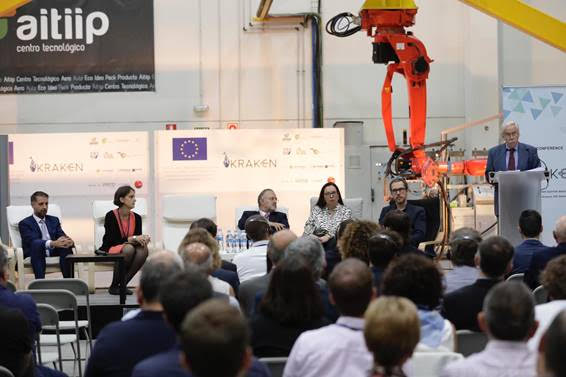Whether you are a fan of pirate movies or not, most likely you know the Kraken as a fearsome but common sea creature of the deep, bearing eight legs and a malevolent temper. Today, however, it is also a fearsome and uncommon 3D printer—capable of churning out industrial parts as it uses both additive manufacturing processes alternated with subtractive operations.
Featuring a working area of 20m x 8m x 6m, the Kraken was developed through a European Project coordinated by Aitiip (headquartered in Spain) in which 15 partners have collaborated for the last three years. Made to produce metal prototypes and parts with WAAM technology, the Kraken extrudes material through a bi-material resin system capable of deposition rates of 120 kg/h.
The subtractive system handles cutting, sanding, and polishing, reaching 2mm of cutting at 10m/minute. A laser tracker controls all these processes, monitoring and controlling the printhead by 1,000 per second—with automatic corrections occurring as needed. The Kraken also includes two different cameras imbued with artificial vision systems for controlling deposition flow, along with verifying the printed part via a 3D scanner.
“The machine is ready for the market, it has been tested in a real manufacturing environment and project demonstrators have been validated by the companies in real conditions,” said José Antonio Dieste, Aitiip researcher and project coordinator. “We can deliver new pieces or install Kraken cells according to client demands.”
This unique new 3D printer is an all-in-one manufacturing system, featuring an embedded metrology system, and offering:
- System calibration
- Frame alignments
- Realtime correction
- Ability to print both metallic or hybrid parts
- Quality inspection of semi-finished or final parts
“Due to the integrated Leica Absolute Tracker, parts manufactured by the Kraken machine can be digitized in 3D and checked against the CAD design to verify the quality of manufacturing over the full volume of the machine, even fully automated if needed,” said Markus Steiner of Hexagon Manufacturing Intelligence.
Not surprising, industrial companies have shown interest in the results of the Kraken, with Airbus confirming that ‘hybrid technologies is not the future but the present and since now the company is going to demand tools and tooling manufactured with this technology no matter where or who produces it.’
Others, such as members of the automotive industry, have shown interest in the Kraken, with Vito Guido of GroupMaterials Labs, CR Fiat stating that the technology ‘will be used for sure for mock-up productions. Guido also states that the technology offers quality results on time. A mockup of the latest Pininfarina car has been fabricated also for design validation, measuring 2.2 x 1 x 0.6 m with a weight of 250 kg.
The Kraken allows for the production of versatile composite materials such as those made from carbon and glass, and will be useful in other applications like:
- Aeronautics
- Railways
- Maritime
- Off-shore and wind infrastructure
“Guaranteeing accuracy in large workspaces (100m2) is a challenge that Kraken has solved by integrating real time laser tracking technologies within the closed loop control of the robotic system. Thanks to this method, tool precision can be assured down to 0,1mm,” said Francesco Crivelli, CSEM SA, who was responsible for designing the control algorithms and implementing the software.
Hybrid 3D printers are becoming more common as users demand the benefits of both additive and subtractive—from wire arc systems to scalable systems to other hybrid printers. What do you think of this news? Let us know your thoughts! Join the discussion of this and other 3D printing topics at 3DPrintBoard.com.
Subscribe to Our Email Newsletter
Stay up-to-date on all the latest news from the 3D printing industry and receive information and offers from third party vendors.
You May Also Like
Further Understanding of 3D Printing Design at ADDITIV Design World
ADDITIV is back once again! This time, the virtual platform for additive manufacturing will be holding the first-ever edition of ADDITIV Design World on May 23rd from 9:00 AM –...
3D Printer Maker EVO-tech Reborn as NEVO3D — Once More With Feeling
EVO-tech was a 3D printing service and original equipment manufacturer established in 2013 and based in Schörfling am Attersee, Austria. The company produced high-quality material extrusion systems featuring linear bearings,...
3D Systems Brings 3D Printed PEEK Cranial Implant to the U.S. with FDA Clearance
For more than 10 years, 3D Systems (NYSE:DDD) has worked hand-in-hand with surgeons to plan over 150,000 patient-specific cases, and develop more than two million instruments and implants from its...
CDFAM Returns to Berlin for Second Annual Symposium
The second CDFAM Computational Design Symposium is scheduled for May 7-8, 2024, in Berlin, and will convene leading experts in computational design across all scales. Building upon the first event...



































